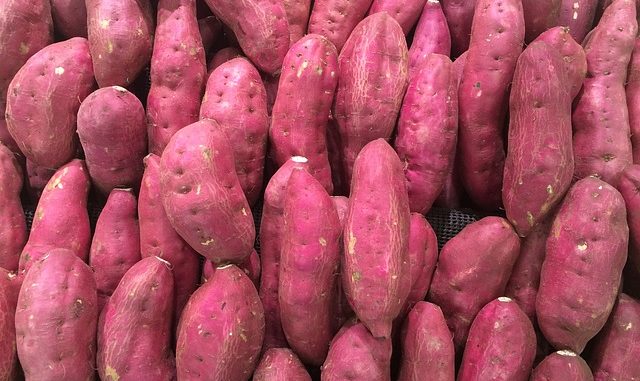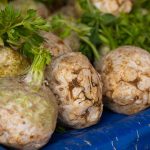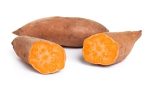
The sweet potato (Ipomea batatas {L.} Lam.) is now a regular feature of the grocer’s retailing shelves. The tubers which are swollen roots are available in orange, purple and actually many colours in between (white through to almost black). They have attracted a great deal of attention over many years because of their high vitamin A content. The tubers however are also rich in fibre, vitamin C and vitamin B6 with plenty of carbohydrate. Not only are the tubers eaten, but the leaves also contribute plenty of nutritional value. The orange varieties are also rich in beta-carotene.
Originally, the sweet potato was found in Central America and Mexico but has been grown commercially in a number of countries which can offer the right growing conditions. The USA, Japan and most parts of the Far East, Australia and Oceania, sub-Saharan Africa, and parts of southern Europe are ideal for commercial production. The crop is now the sixth largest crop in the world.
In the USA, the sweet potato is sometimes called a yam although it is in fact another type of root vegetable.
Availablity In Shops
The best time to find sweet potatoes in the grocers is between October and March.
Cooking With Sweet Potato
A root which is highly versatile. It can be roasted and baked, fried or barbecued. It also makes a good base for soups and stews in combination with pumpkin, squashes and ordinary potatoes. Some chefs like to boil the tuber before mashing to a pulp or pureeing. They make excellent vegetarian fillings for quesadillas and falafels. In the USA, it is a traditional dish to add a syrup such as maple syrup to really sweeten them up. They almost become dessert like.
Leave the skin on when baking or frying them. It is especially important it seems when preparing vegetable crisps. Peeling a sweet potato will cause discolouration. Keep them soaked in cold water until you are ready to use them in a dish. We prepare fries and wedges with them.
Store the roots in a cool, dark place and use within a week of purchase.
Nutritional Value Of Sweet Potato
|
Amount Per
|
| Calories 86 |
| % Daily Value* | |
| Total Fat 0.1 g | 0% |
| Saturated fat 0 g | 0% |
| Polyunsaturated fat 0 g | |
| Monounsaturated fat 0 g | |
| Cholesterol 0 mg | 0% |
| Sodium 55 mg | 2% |
| Potassium 337 mg | 9% |
| Total Carbohydrate 20 g | 6% |
| Dietary fiber 3 g | 12% |
| Sugar 4.2 g | |
| Protein 1.6 g | 3% |
| Vitamin A | 283% | Vitamin C | 4% |
| Calcium | 3% | Iron | 3% |
| Vitamin D | 0% | Vitamin B-6 | 10% |
| Cobalamin | 0% | Magnesium | 6% |
| *Per cent Daily Values are based on a 2,000 calorie diet. |
The sweet potato is grown as a staple but also contains a number of phytochemicals with active health benefits (Bovell-Benjamin, 2007).
The sweet potato is rich in vitamins B1 (thiamine), B2 (riboflavin), C (ascorbic acid) & E (tocopherol) as well as vitamin A. The minerals which are prevalent are calcium, potassium, magnesium and zinc. Dietary fiber and various non-fibrous carbohydrates are also common in the tuber. A number of African countries such as Mozambique (Low et al., 2007) and Uganda (Hotz et al., 2012) are growing the orange sweet potato to overcome the chronic vitamin A shortage in children.
The roots are rich in phenolic acids. The phenolic contents of the sweet potatoes cultivated in the USA range from 0.14 to 0.51 mg of chlorogenic acid equivalent/g fresh weight of hand-peeled storage roots. the main acids are chlorogenic and isochlorogenic acids (Walter et al., 1979). The phenolic content of of a red-fleshed sweet potato cultivar was found to be at an exceptionally high level of 9.45 mg/g fresh weight (32.2 mg/g dry weight) (Cevallos-Casals & Cisneros-Zevallos, 2003). This compares with a fruit such as a blackcurrant which is measured at 21 mg CAE/g fw of berries (Amakura et al., 2000).
Japanese sweet potato is a staple feature of some important diets including the famous Okinawan diet. The yellow-fleshed version is the most common in Japan. There are a number of varieties grown in Japan including Chiran Murasaki, Tanegashima Murasaki, Naka Murasaki, and Purple Sweet.
Why Do Sweet Potatoes Have Different Colours ?
Sweet potatoes have a rich and complex anthocyanin profile. Anthocyanins are the pigments which give most red-purple fruits their rich colour and this is no different in the sweet potato. Analysis shows two important types – cyanidin-3-(6′′-caffeoylsophoroside)-5-glucoside and peonidin-3-(6′′-caffeoylsophoroside)-5-glucoside (Montilla et al., 2010). Purple-fleshed sweet potatoes developed in Japan contain about 0.4–0.6 mg anthocyanins/g fresh weight (Furuta et al., 1998).
Recently twelve kinds of anthocyanins were extracted from Chinese purple sweet potato cultivars (Sun et al., 2018). Five of these anthocyanins were based on peonidin which tends to produce the strong purple pigment colour.
The purple varieties probably have better health claims. Generally, anthocyanins are very good antioxidants. they have the capability of scavenging and mopping up free radicals which is the basis for their remarkable health benefits.
Gut Health Is Improved By Consuming Sweet Potato
Fibre in both its soluble and insoluble forms is a very effective nutrient for promoting good gut health. Soluble and insoluble fibres are often fermented by gut bacteria throughout the gut but predominantly in the colon. These bacteria produce small compounds called small-chain fatty acids (SCFAs) which act as fuel for cells that line the intestine (Topping & Clifton, 2001). We know that a good fibre based diet should yield between 20 and 35 grams of fibre every day (Dahl & Stewart, 2015). Sweet potato, in the diet, contributes to that fibre requirement. Plenty of fibre is linked to good bowel movements, firmer stools and a lowering of the risk of colon cancer
It also appears that the anthocyanins in sweet potato promote or modulate the growth of probiotic bacteria such as Bifidobacterium bifidum, Bifidobacterium adolescentis, Bifidobacterium infantis and Lactobacillus acidophilus (Sun et al., 2018). These same anthocyanins also appear to inhibit the growth of unpleasant bacteria such as Staphylococcus aureus and Salmonella typhimurium. These two microorganisms are responsible for some very serious food related diseases.
Cancer
We have already mentioned how fibre in the diet is associated with reducing the risk of developing colon cancer. Sweet potato offers plenty of soluble and insoluble fiber for consumption which benefits us in this important area of gut health. The anthocyanins too could also be playing their part if recent research evidence is anything to go by.
There is an anthocyanin-enriched purple-fleshed sweet potato clone called P40 which has an anti-cancer effect in both cell cultures and in an animal model. In the study cited the suggestion was made that this P40 clone could protect against colorectal cancer because it stopped cell cycles in the cancer cells. The effect was attributed in part to the purple anthocyanins but also some phenolics.
Sweet Potato Leaves
The leaf is the byproduct of tuber production but has nutritional health properties in its own right. These have been consumed in traditional Chinese medicine to combat heart disease (arteriosclerosis), protect eyesight and reduce tumor production (Han, 2000). The juice from the plant is also consumed by people with diabetes mellitus (Type-2) in parts of India such as Sikkim and Darjeeling.
References
Amakura, Y., Umino, U., Tsuji, S., & Tonogai, Y. (2000). Influence of jam processing on the radical scavenging activity and phenolic content in berries. Journal of Agricultural and Food Chemistry, 48, pp. 6292–6297.
Bovell-Benjamin AC (2007) Sweet potato: a review of its past, present, and future role in human nutrition. Adv Food Nutr Res. 52 pp. 1-59 (Article).
Cevallos-Casals, B. A., & Cisneros-Zevallos, L. A. (2003). Stoichiometric and kinetic studies of phenolic antioxidants from Andean purple corn and red-fleshed sweetpotato. Journal of Agricultural and Food Chemistry, 51, pp. 3313–3319
, & (2005). Antidiabetic plants used by Sikkim and Darjeeling Himalayan tribes. India Journal of Ethnopharmacology, 99, pp. 199–202
Dahl, W.J., & Stewart, M.L. (2015) Position of the Academy of Nutrition and Dietetics: health Implications of Dietary Fiber. J. Acad. Nutr. Diet 115 (11) pp. 1861-1870 doi: 10.1016/j.jand.2015.09.003 (Article)
Furuta, S., Suda, I., Nishiba, Y., & Yamakawa, O. (1998). High tertbutylperoxyl radical scavenging activities of sweetpotato cultivars with purple flesh. Food Science and Technology International of Tokyo, 4, pp. 33–35.
(2000). Good Vegetable and Medicine–Ipomoea batatas leaf. Agriculture of Hunan Province, 6, pp. 27.
Harada, K., Kano, M., Takayanagi, T., Yamakawa, O., & Ishikawa, F. (2004). Absorption of acylated anthocyanins in rats and humans after ingesting an extract of Ipomoea batatas purple sweet potato tuber. Bioscience Biotechnology and Biochemistry, 68, pp. 1500–1507.
Hotz C, Loechl C, Lubowa A, Tumwine JK, et al. (2012) Introduction of beta-carotene-rich orange sweet potato in rural Uganda resulted in increased vitamin A intakes among children and women and improved vitamin A status among children. J. Nutr. 142 pp. 1871–1880.
Lebot, V. (2009). Tropical root and tuber crops: cassava, sweet potato, yams and aroids (Vol. 17). Cabi.
Lim, S., Xu, J., Kim, J., Chen, T. Y., Su, X., Standard, J., … & Tomich, J. (2013). Role of anthocyanin‐enriched purple‐fleshed sweet potato p40 in colorectal cancer prevention. Molecular Nutrition & Food Research, 57(11), pp. 1908-1917.
Low, J.W., Arimond, M., Osman, N., Cunguara, B., et al. (2007) A food-based approach introducing white-fleshed purple skin sweet potatoes increased vitamin A intake and serum retinol concentrations in young children in rural Mozambique. J. Nutr. 137 pp. 1320–1327.
Montilla, E. C., Hillebrand, S., Butschbach, D., Baldermann, S., Watanabe, N., & Winterhalter, P. (2010). Preparative isolation of anthocyanins from Japanese purple sweet potato (Ipomoea batatas L.) varieties by high-speed countercurrent chromatography. Journal of Agricultural and Food Chemistry, 58(18), pp. 9899-9904 (Article).
Oki, T., Masuda, M., Furuta, S., Nishiba, Y., Terahara, N., & Suda, I. (2002). Involvement of anthocyanins and other phenolic compounds in radical scavenging activity of purple-fleshed sweet potato cultivars. Journal of Food Science, 67, pp. 1752–1756.
Oki, T., Osame, M., Masuda, M., Kobayashi, M., Furuta, S., Nishiba, Y., et al. (2003). Simple and rapid spectrophotometric method for selecting purple-fleshed sweetpotato cultivars with a high radicalscavenging activity. Breeding Science, 53, pp. 101–107.
Steed, L. E., & Truong, V. D. (2008). Anthocyanin content, antioxidant activity, and selected physical properties of flowable purple‐fleshed sweet potato purees. Journal of Food Science, 73(5), S215-S221.
Suda, I., Oki, T., Masuda, M., Kobayashi, M., Nishiba, Y., & Furuta, S. (2003). Physiological functionality of purple-fleshed sweet potatoes containing anthocyanins and their utilization in foods. Japan Agricultural Research Quarterly: JARQ, 37(3), pp. 167-173
Sun, H., Zhang, P., Zhu, Y., Lou, Q., He, S. (2018) Antioxidant and prebiotic activity of five peonidin-based anthocyanins extracted from purple sweet potato (Ipomea batatas (L.) Lam.). Sci. Rep. 3 Mar 22 8(1):5018 doi: 10.1038/s41598-018-23397-0
Teow, C. C., Truong, V. D., McFeeters, R. F., Thompson, R. L., Pecota, K. V., & Yencho, G. C. (2007). Antioxidant activities, phenolic and β-carotene contents of sweet potato genotypes with varying flesh colours. Food Chemistry, 103(3), pp. 829-838.
Topping, D.L. & Clifton, P.M. (2001) Short-chain fatty acids and human colonic function: roles of resistant starch and nonstarch polysaccharides. Physiol. Rev. 81 (3) pp. 1031-1064 (Article)
Walter, W. M., Jr., Purcell, A. E., & McCollum, G. K. (1979). Use of high-pressure liquid chromatography for analysis of sweet potato phenolics. Journal of Agricultural and Food Chemistry, 27, pp. 942–946
Yoshinaga, M., Yamakawa, O., & Nakatani, M. (1999). Genotypic diversity of anthocyanins content and composition in purple-fleshed sweet potato. Breeding Science, 49, pp. 43–47.
Yoshimoto, M., Okuno, S., Yoshinaga, M., Yamakawa, O., Yamaguchi, M., & Yamada, J. (1999). Antimutagencity of sweetpotato (Ipomoea batatas) roots. Bioscience Biotechnology and Biochemistry, 63, pp. 537–541.


Leave a Reply